Covering Ground (literally)
- Brianna Clark
- May 7, 2021
- 12 min read
Updated: May 8, 2021
Footing pour day, our first concrete pour ever
What is the #1 concern that one has while pouring concrete? Let me rephrase. What is the #1 concern that one has while pouring concrete if you have never done it before and you do not work in the concrete business for a living? Rain? No, lightning? There sure is a lot of metal rebar.. The pump truck and the concrete trucks not aligning on the schedule and someone forgets to show up? Did we calculate enough concrete for our order? Was it the right mix? (More on that later). Did we get the dimensions of the footings right? If we didn’t, there will be some “artistic” looking rebar sticking out of our foundation, and we are not going for the “Modern/industrial” style.

To be honest, all these questions were cycling through my brain the night before our scheduled pour, but the main question was did all of us common people that have never built a foundation before adequately construct a sturdy enough forming system that would hold together during 135 tons (yes really) of concrete being poured into it? Of course I am not minimizing the help we had from our commercial concrete friend and mentor, Old 40 Grit (Jim) and his guys, but paranoid worrywart me hardly slept the night before. It is not like you get a second chance on this sort of thing.

The paranoid worrywart gene must run in my family, since randomly my own carpenter dad would show up rain, shine, or rain, to reinforce just one more section... and then keep doing that every few days until the pour. I was pretty confident that the rebar was solid. If you read our previous post, it was massively over-engineered and designed for the crappiest load bearing soil out there, and if you haven’t read any of our previous posts, we had to rotohammer our soil just to drive the form board stakes into the ground deep enough to even start our footing forms. Anyways, to support the footing forms the best, we had to build “kickers” that were nailed into the outside of the form boards and braced against either a rock or dirt bank to ensure that the forms would remain vertical and would not tilt or bow out when all the weight of the concrete was pressing against it when filled. You know, physics! We spent days reinforcing the footing forms and were still doing it during the actual pour!
We shot awake just before 7 am the day of the pour. Although terrible morning people, there was no way we were going to hit snooze that day. The instant the alarm pierced through the chilly morning air our brains were turning. It was go time. We sprinted down the driveway to meet our team. Old 40 Grit was there with the same lads (Bryce and Donny) that had helped us start our forms from the beginning. Luckily for us Jim had also recruited another guy from the concrete world, Charlie, who would be running our pump truck hose for us. We also had Dad Brian as the standby carpenter in case emergency repairs were required. Myself, Boyfriend Brian, Jordan, Matt, and Dan were all on standby to jump in wherever necessary. Sounds like a lot of people for just a footing pour, but we actually ended up needing everyone.
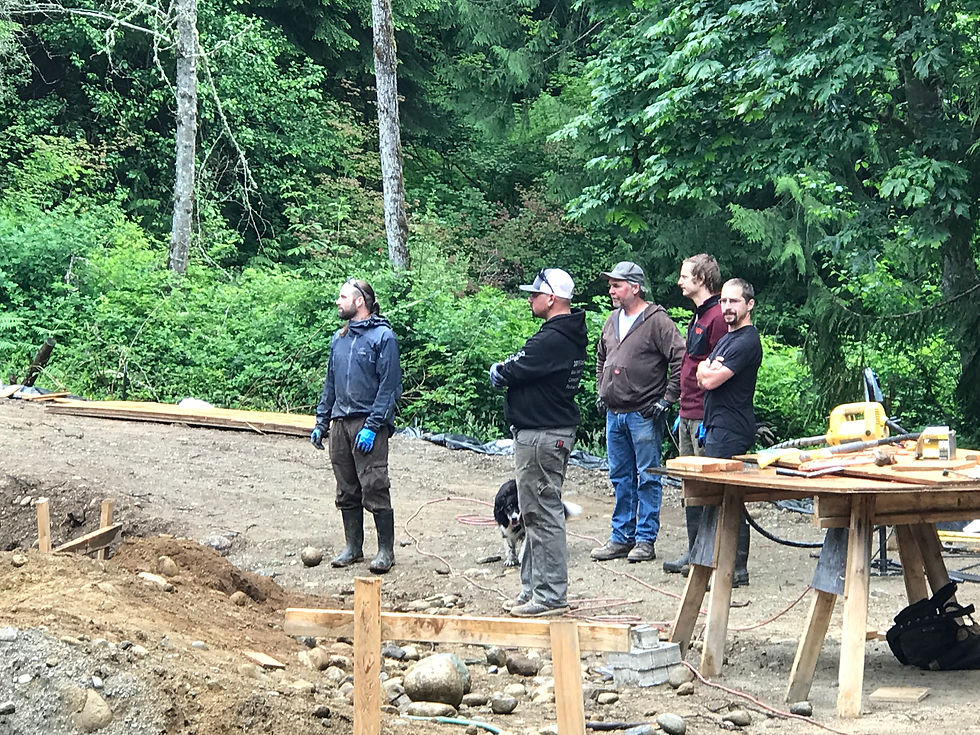
Both the pump truck company and the concrete company confirmed with me multiple times that I really needed a 6.5 sack mix just for footings. Of course, at that time I had no idea what I was talking about and maybe it showed, except our plans really did specify this strength of concrete. For the nerds or noobs (me) out there, concrete is a mixture of aggregates (rock, sand, or gravel), water, sometimes air, and cement (calcined lime and clay). Historically, the cement comes in 94 pound bags. The number of “sacks” in a concrete mix specifies the number of bags of cement that are added to the mix, and the more “sacks” the mix has, the more pounds of compression the concrete can handle. Moving on... I greeted the team with nervous energy and then zipped off to pick up our concrete vibrator we had rented from a place in town. The concrete vibrator is critical when pouring footings because the vibrations force the air bubbles out of the concrete mix to get a more compacted pour. Everyone else got busy adding more and more kickers, patching holes, and scrambling to finish our bulk heads wherever there were steps required in the concrete. Back on the scene, I strapped on my toolbelt and helped patch up some holes while constantly checking the time. It was 9:00 A.M. The pump truck should have been here already. Did everything go smoothly on their end? Should I call? I am largely of Scandinavian decent, which typically means I will not “inconvenience” another person by calling them to make sure they are on schedule. The pump truck needed to arrive earlier than the mud truck so they can set up in advance so they do not prevent delay in concrete distribution from the mud truck to the footings. If the mud truck arrives too early, they could potentially have to keep adding water to the mix to keep it at a consistency that would flow through the hose, which would weaken the strength of the concrete over time. It would also throw off the timing of the 6 other mud trucks I had lined up specifically to deliver 45 minutes apart. They were coming from an hour away, so it was critical they stayed on schedule for a consistent pour. My heart was pounding. All these people had woken up early on a Saturday to help us and were scrambling on my behalf. Had I communicated correctly? What if the mud truck gets here before the pump truck and is just waiting around? Just as soon as I thought of it, I heard the unmistakable “BEEP...BEEP” of a large truck backing up our steep driveway. 9:11 A.M. We all peered anxiously down the driveway. “Shit! It’s the mud truck!” Yelled Charlie. Oh no, I thought, how far behind is the pumper?
The concrete guys through their arms up in the air. They knew this could turn into quite the day. Had I blown it? Just as I started to dial the number to the pump truck company, Brian had a fantastic idea. Remember that gargantuan (6’9” wide, 14” deep) footing we have?

It was so big, we figured that we might as well just have the truck dispense his whole 10 yards straight into it so we could get going and stay on schedule. Luckily, it was one of the lowest elevation footings we had, so it might make sense to start there to strategically avoid any blow outs due to simple gravity. The driver said that that was a good idea, as did Charlie, so we started to back the truck right up to the footing. He got into position and started spinning his drum, revving up to dump it out. All of us stood by with nervous anticipation, toolbelts on, ready to start reinforcing the forms if any started to give way since all 10 yards of concrete was going right in one spot. Right as he gave the signal he was going to dump, we heard another roar of a truck blowing up our driveway. I hung up my phone and ran around the corner to see none other than a whir of giant blazing red truck with black flames. The pump truck made it! Whew!

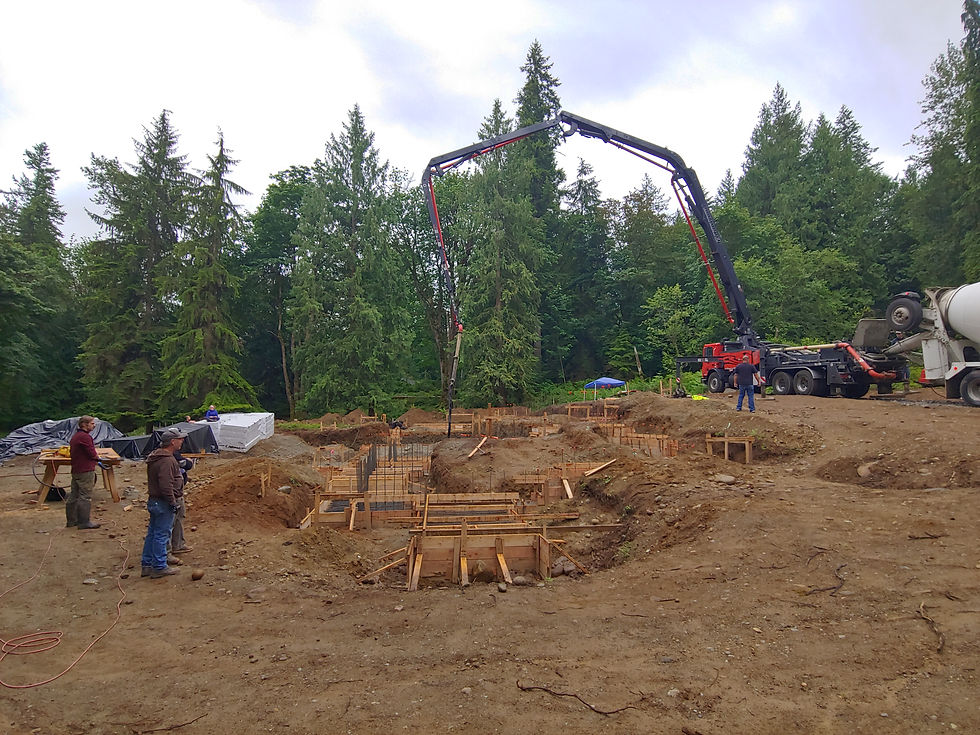
The concrete truck driver knew the drill. He pulled up next to the pump truck and folded out his chute to transfer the mud to the pumper. The pump truck driver (Dean) jumped out and sprinted around his truck flinging out his outriggers to stabilize the vehicle. We had required a 100 foot boom for this pour, so stabilizing was necessary. In almost no time, he was ready to go with his control box strapped to his belt and the pumper loaded with concrete. The boom extended and maneuvered slowly over to Charlie, who eagerly grabbed the pump hose and gave the signal he was ready to go. The concrete came pouring out in a rush and we all stood by with our toolbelts and magnesium floats (for finishing) ready. That’s when it all happened. The forms wobbled... Cracked... Creaked with agony, and gave way.. BOOM! EXPLOSION! CONCRETE EVERYWHERE...
Just kidding. The footing was so comically huge the first truck dumped its entire load into it as expected and a few surrounding ones, and off it went. Charlie told me to call the truck company and try to cut the spacing in between trucks down to 20 minutes (instead of 45) since it seemed like this would go much quicker than planned. Maybe this would be easier than we thought? While I was calling the concrete company, I heard some commotion and suddenly everyone with a float jumped into action to start coaxing the rocky concrete into smooth surface. Sure, they were just footings, so they didn’t have to be perfect, but the smoother the top is, the nicer it would be to snap lines for walls in the next phase. Brian called to me to get off the phone and hurry up, since the concrete was already hardening! Shoot! I had keyway duty! Brian had already started scraping a line in for me, but he had to jump to the next section to start floating. I grabbed my keyway scraper that Jim had made for me and got to work, frantically trying to keep up while pretending that I knew what I was doing. A keyway is just a slot carved into the top footing surface to give additional bonding strength to the concrete wall that will eventually be installed on top of the footing. Some people said we didn’t need them, but of course our eager-beaver engineer included that detail, so we did it.
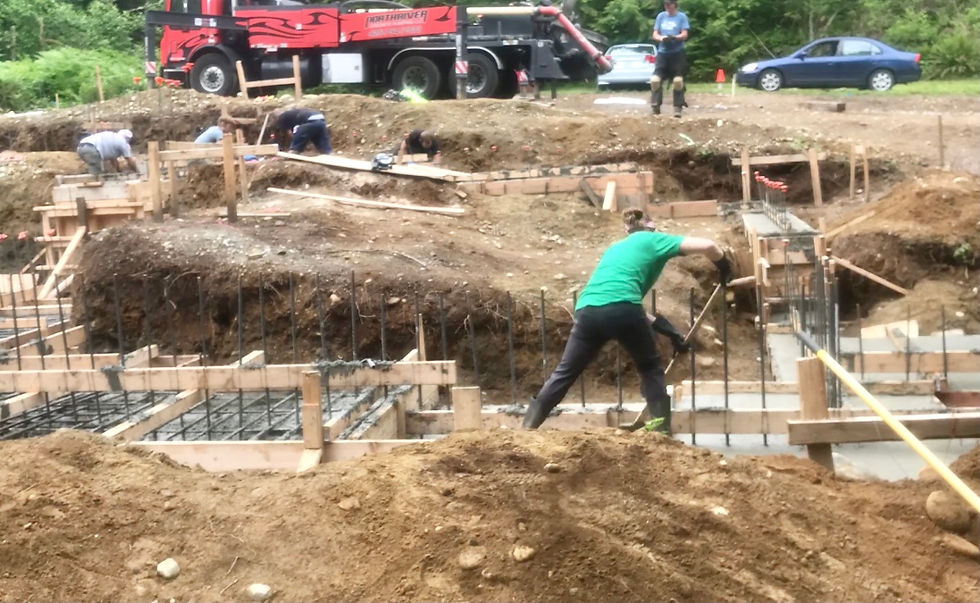
I made it through the first couple footings but the jig started to break, and I wasn’t going fast enough. The concrete was hardening so quickly that my keyway was getting continuously skinnier and sloppier. Donny and Matt ran the vibrator, which we 100% had given a phallically symbolic name that I won’t repeat here for the virgin ears attached to the people reading this blog.

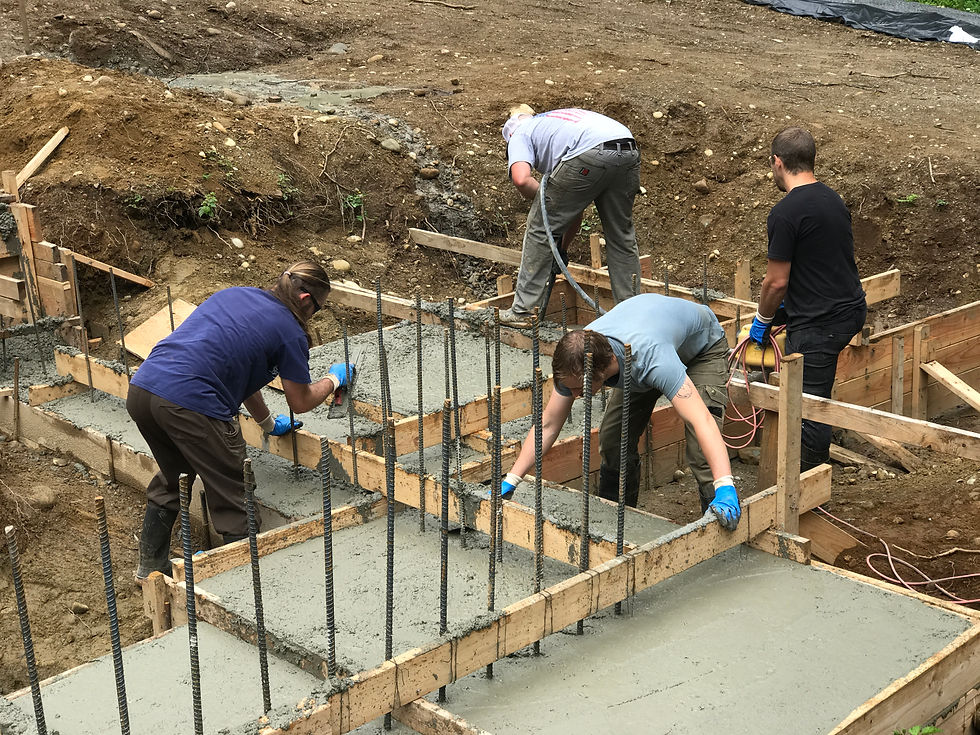
Bryce, Dad Brian, Jordan, and Boyfriend Brian were all way ahead of me floating and gliding right along. My dad jumped out of the line of floats and started sawing and banging something together at the sawhorse. Did something blow out that he saw? I fiddled along with my jig. Suddenly, my dad ran over and handed me the most beautifully constructed keyway jig, but with 5 times the amount of length than the jig I had. “Here you go!” He said and hopped back out of The Pit to make another for himself. Wow, he noticed that we needed a different method to keep this up. Whatta guy!

Meanwhile, we had all been waiting around for the next truck to arrive. They were trying to speed up the spacing, but it just wasn’t working since they were located so far away. Our concrete was hardening at a rate that if they didn’t close the gap, it might get real ugly. We all anxiously watched as the concrete set up, and the minutes ticked by, and no truck came. My dad started adding more reinforcements to the huge column step we had going from the top of the west footing all the way down to the basement footing. Both Brians and Jordan had already spent significant time throwing lumber at that thing, but what else do you do when you’re waiting for the mud truck? This would also be our next point of anticipation, because if this column blew out, we would have a LOT more work on our hands, for real.
As soon as the next truck arrived, Charlie asked the driver to call all the other trucks to the site at once. It was the moment of truth. The column pour. Charlie skillfully poured slowly and steadily down into the bottom, let the vibrator come in periodically to stab around and get all the concrete settled, and proceeded to add another layer. All of us watched feverishly as more and more concrete piled in. A few spots were leaking to the sides, but overall, that thing didn’t even bulge! I was proud of us! The worrywart genes pay off sometimes, I guess!
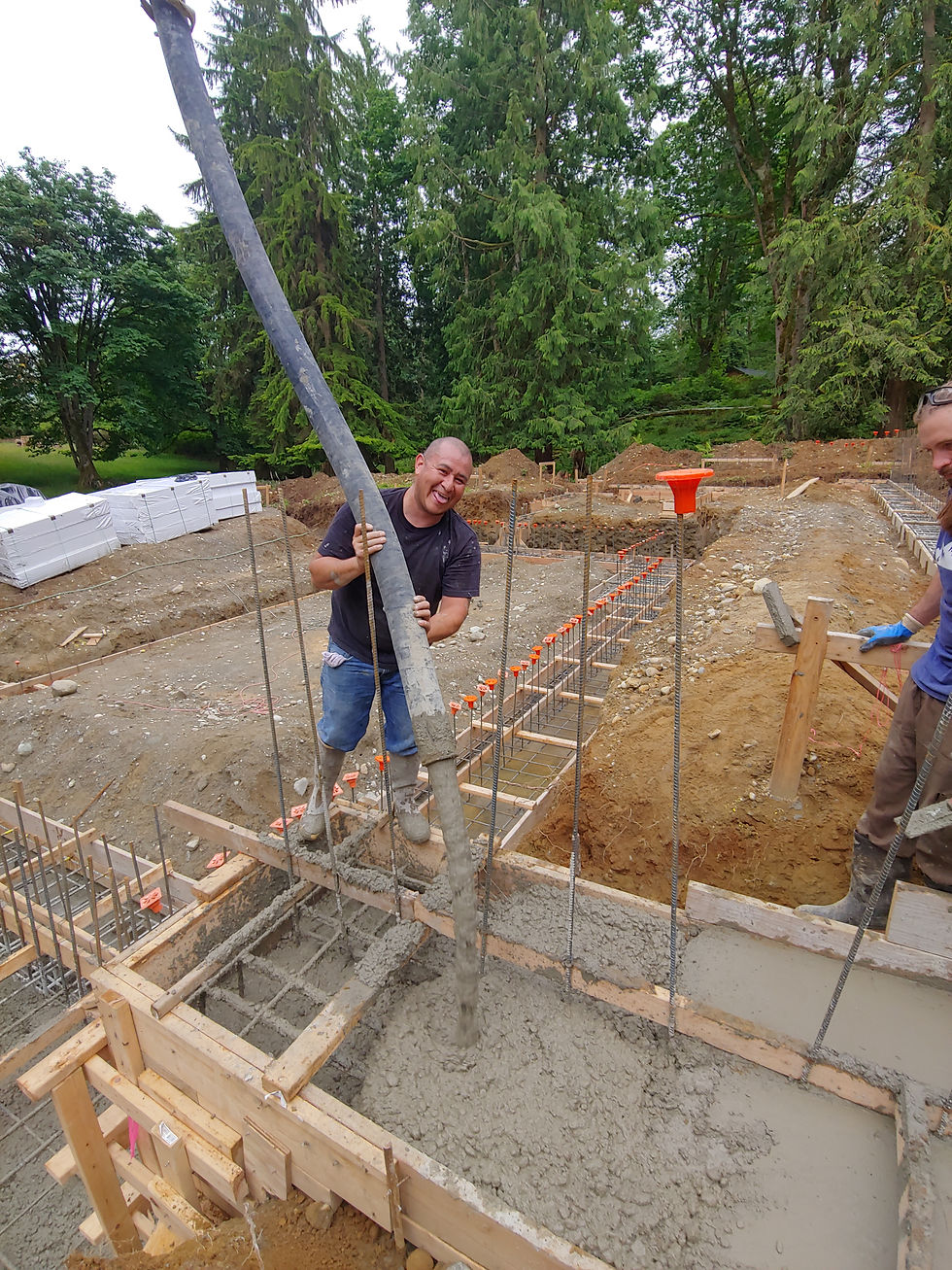
We waited again on the next truck but at least they were super quick at hooking up. Mud started rushing down the hose and we had only gotten a little more done and then CLANG! The mud stopped. What was that? Dean told me, “Yep, it’s clogged. That’s what happens when there has been a little too much time between trucks with a heavy mix like this.” Noted. Dean banged on the hose with a hammer, and it wouldn’t budge. Minutes going by, concrete still hardening quickly, he pried and banged and eventually the hose flung off the end of the boom and dumped the rocky paste that got jammed inside. Quickly reassembling, we got back up and running. This happened a couple more times. Ugh, the agony! Of COURSE after the hose kept clogging, now we had 2 trucks there at once! Go figure. Now we were really scrambling. Charlie made the call to add just a bit of water to the next truck’s mud, to see if that would buy us a little more time. The mud came, we poured and smoothed and scraped, the pump hose snaking around the job site with all of us in tow. Finally, over halfway through and we were getting the hang of it, the slightly wetter mud was working much better, and the trucks were finally showing up one after another! Hooray! Were we going to pull this off? A little more precious time would tell, since one of the drivers told us the final truck was leaving the station and we had to make the call on how much concrete this truck would need to bring to finish the job. Charlie shot his tape measure across the remaining empty footings and measured the distance of each to calculate the yardage of concrete it would take to fill them up. We figured 7.5 yards to go and we would call it a day.

At this point, even though people were still moving quickly to float, I was finished with keyway duty. I helped float for a little while, but then I stood back and finally looked up at the whole site for the first time since we started. Wow. We had covered some ground. Quite literally. See what I did there? I didn’t get to stand back and enjoy for long, though, since Dean wandered over with his control box and said, “Wanna drive?” I looked at him, kind of bewildered, and said, “Seriously?” I got nervous all over again, because I am who I am. The final truck had arrived and was waiting for our signal. We were on our last footing, which was our smallest. But I still didn’t want to screw it up. What if I ended up flinging the hose everywhere and wasting our precious concrete and we didn’t end up having enough to complete the footing?? I looked at the guys and everyone was waiting for me to take charge. It would be dumb not to take up this offer, because I would probably never get it again, unless I went into concrete pumping for a living.
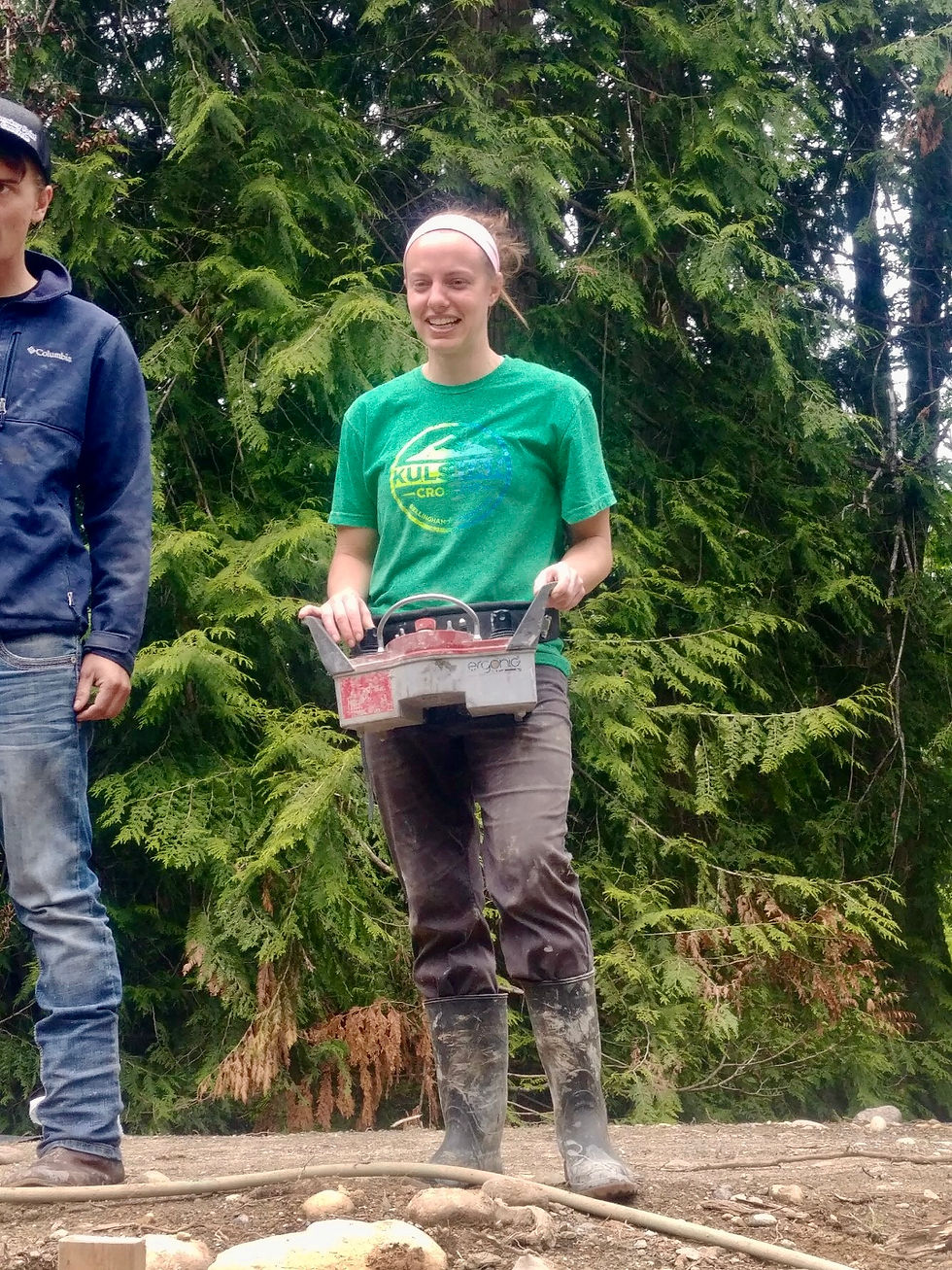
I grabbed the controller and could barely even figure out how to strap the belt on. Good start. Dean gave me an overview of all the knobs and buttons and slide controls. I jabbed at a slide control and the pump hose jerked over to the wrong side of the footing. “Oh God” I yelled, and he said, “That’s ok, just a little more finesse,” but obviously he didn’t know that everything I do is rough and tumble. I poked at a few more of the buttons and got a sense of direction, but the thing moved up, down, forward, backward and to each side. The trick was to do them all in sync so it would make a consistent movement with the hose, kind of like an XBOX controller. He verbally commanded the directions while I turned the mud flow button to the on position. It was going just okay, but luckily Charlie was a good sport and made use of my awful jerky movements and got most the concrete actually inside the footing. I started concentrating really hard, kind of getting the hang of it, and all of a sudden Charlie started flinging about, the hose going out of control! “SORRY CHARLIE, I am so bad at video games!!!” I yelled from the bank and started freaking out trying to hand the controller to Dean. That is when Charlie let go of the hose and everyone started laughing. Charlie was a good actor. “Damn it, Charlie!” I bellowed, although I was cracking up. We ran a couple more minutes of concrete and we were done! I couldn’t believe it. Not a single blow out, no one got hurt, and we had poured more concrete in these footings than most people do for their entire foundation!
Later, we looked it up, and it appears that a foundation for an average house is 40 yards total. Our footings ended up taking 67 yards! Fun fact, this equates to 271,774.71 pounds, or the weight of 11 standard school busses or 75 Subaru Outbacks ( a local reference since we are in Washington state and this is the car everyone and their mom, sister, uncle, and best friend drives). The trucks drove away and we all cracked Pub Beers for celebration while admiring the hardening concrete, which as you can imagine is about as exciting as watching a pot of water boil, but it had been 5.5 hours of a nonstop grind so we really didn’t get to look at what we had accomplished until now. It was then that Brian sipped his beer and said to us, “Well, tomorrow is a day off. But the next day we are demoing these footing forms and starting walls.” Just like that, the mood was killed. Brian truly has such a way with words, doesn’t he? My eyes widened.. if this is what pouring footings were like, albeit gargantuan footings, what in the hell would constructing wall forms look like and how much concrete would we need for these? Dun da dun dun!

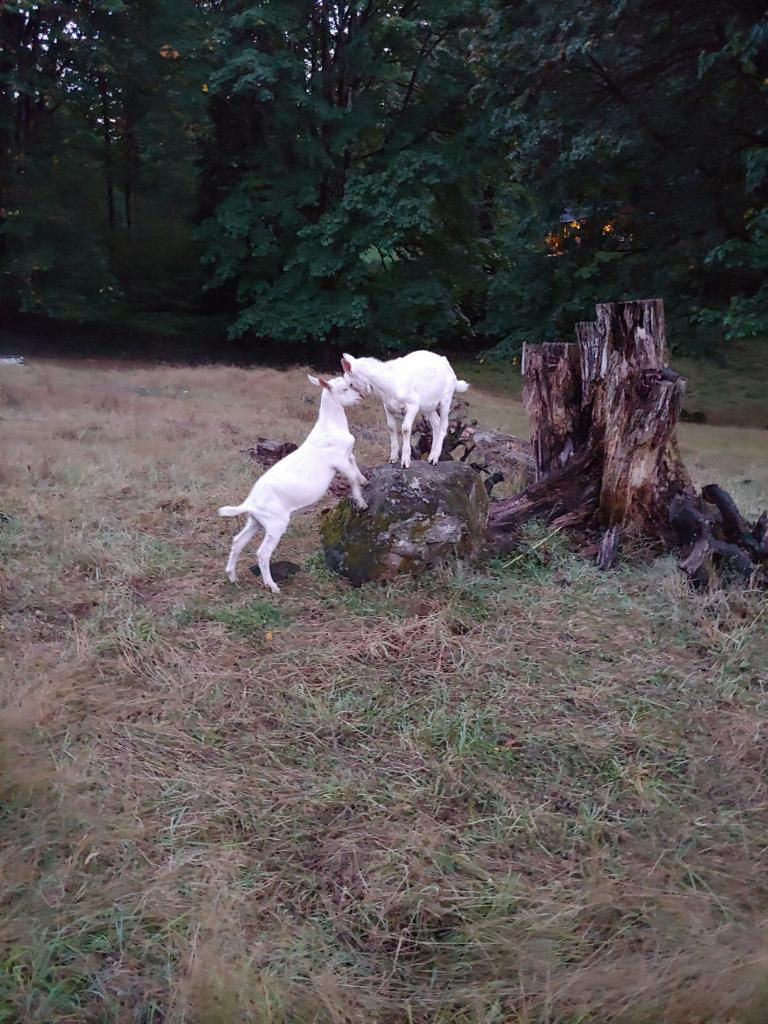




























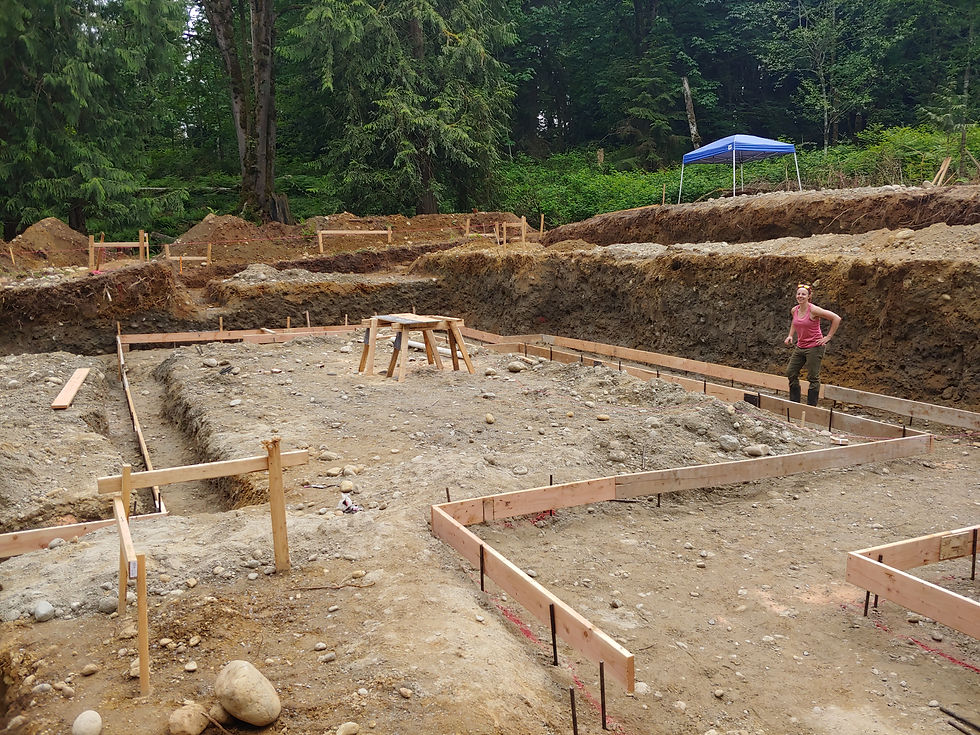



Comentários